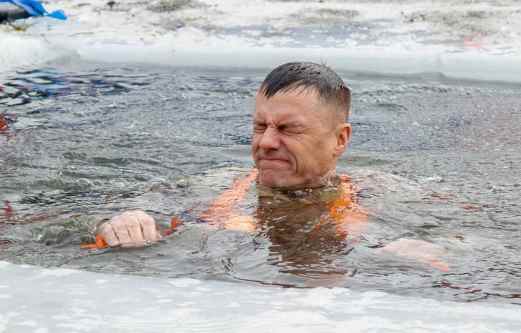How Can I Stay Warm in Cold Water without a Wetsuit?
You can swim in cold water without a wetsuit and have an exhilarating and invigorating experience, if you are brave enough to take the plunge.
Whether you’re a cold water swimming enthusiast or you just want to challenge your limits, there are ways to enjoy swimming in low temperatures safely and comfortably.
Here, we shall explore how to stay warm, prepare for swimming in the cold sea, adjust to icy pool water, and extend your cold water swimming sessions without a wetsuit.
It is not always that you will have a wetsuit with you. However, don’t let this keep you from swimming when the weather is cold.
How can I stay warm in cold water without a wetsuit?
A wetsuit is warmer than a swimsuit, because it creates a buffer zone between your body and the cold water. That way, the body will not lose its heat to the cold water.
Taking a dip in the cold water without a wetsuit requires you to employ proper techniques to stay warm, and avoid hypothermia.
Your body naturally loses heat more quickly in cold water. Thus, it’s crucial to employ strategies to maintain a comfortable temperature.
How to avoid cold shock response
When you plunge into cold water, you will experience “cold shock response.” When this happens, your body loses heat fast, the skin becomes cold, and your heart rate rises rapidly. Obviously, the next thing will be to start drowning.
But it is avoidable!
When you first enter the cold water, try to stay as still as possible and control your breathing.
Gradually immerse yourself, allowing your body to adapt to the coldness of the water. This initial shock response usually subsides within a few minutes.
You can layer your swimming attire
Don’t just wear the swimming attire that you regularly wear in summer.
Try the technique of layering your swimwear. Start with a snug-fitting swimsuit as your base layer, followed by a neoprene vest or shirt.
Neoprene is an excellent insulator that traps a thin layer of water between your skin and the fabric, creating a thermal barrier to keep you warm.
Remember to wear a swim cap for swimming. These caps can help conserve heat by reducing heat loss from your head.
High-quality silicone or latex swimming caps are recommended for their insulating properties.
How to prepare for a dip in cold water

Before diving into the icy waters, proper preparation is essential. Begin by acclimatizing your body to lower temperatures gradually.
You can do this by taking cold showers or baths regularly, as that allows you to feel used to the coldness. Gradually decrease the water temperature over time to build your tolerance.
It’s also crucial to check the weather and water conditions before each cold water swimming session.
Avoid swimming in cold or stormy weather, as it can be dangerous. This is one way you can drown while swimming in the ocean.
Always have a friend or a lifeguard present, especially if you’re new to cold water swimming.
Incorporate a pre-swim warm-up routine to get your blood circulating. Jumping jacks, arm swings, and gentle stretches can help prepare your body for the cold.
How to get used to cold pool water fast
If you must take a dip in cold water, you should try as hard as possible to get your body acclimatized to the low temperature.
Here are a few vital ways to get used to the coldness of the salt or chlorinated swimming pool water faster.
Gradual exposure to the coldness
Start with getting into a cold shower. Also, this is not the time to test the pool depth for diving.
Rather, slide into the water slowly to help your body get acclimatized to the low temperature.
Start with shorter swims in the low temperature water and progressively increase the duration as your body adapts. Push your limits sensibly.
Control your breathing
Focus on deep, controlled breathing to reduce anxiety and maintain body heat. Inhale slowly through your nose and exhale through your mouth.
Breathing in the open water or in the pool is a vital skill. It can determine how long you can stay in the water.
Prepare mentally
Positive visualization can help you overcome the initial shock of cold water. Imagine yourself comfortably swimming in chilly waters. Let your mind get used to the idea that you are going to jump into very cold water.
Take cold showers
I already mentioned this, but a good thing is worth mentioning twice. Take cold showers regularly to condition your body and mind for the sensation of cold water.
Cold water showers can bolster your immune system and make your metabolism faster, as we saw in the post on swimming in cold water.
How long can I swim in cold pool water without a wetsuit?
The duration you can swim comfortably in cold pool water without a wetsuit depends on various factors.
These factors include your individual tolerance, water temperature, and your body’s cold adaptation.
In moderately cold conditions (around 50-60°F or 10-15°C), you can endure sessions of 30 to 60 minutes, or more. Please note … this is only possible if you have some experience.
It’s essential to listen to your body. Exit the water if you start feeling extremely cold or experience numbness.
What can I use instead of a wetsuit in a cold pool?
If you don’t have a wetsuit for swimming, there are alternative options for other swimming attire for men, and women to consider:
Neoprene accessories – These include things such as neoprene swimming gloves, caps, vests, and booties. They can provide extra insulation and extend your cold water swimming time.
Thermal swimwear – Specialized thermal swimsuits with thicker materials and built-in insulation can help to keep you warm in the cold days.
Layered clothing – Layering thin, tight-fitting swimsuits and rash guards can create a barrier against the cold. You can follow these with a neoprene vest or suit.
Use swim Floats – In addition to providing buoyancy, swim floats can insulate your upper body when used as a tow float.
What Is the Secret to Cold Water Swimming?
The secret to successfully dipping in cold water lies in the delicate balance between physical preparation and mental fortitude.
While it may seem daunting at first, getting to finally take a dip in ice-cold water can be deeply rewarding.
Here are the secrets to enjoying swimming in low temperatures:
Mental resilience – winning starts in the mind
Swimming in the cold water requires a strong and positive mindset. Embrace the cold as a challenge rather than an obstacle.
Visualize yourself conquering the chill and focus on the invigorating sensations that come with it. Your attitude can help you to adapt to the cold water fast.
Check: Dream of swimming in the ocean
Safety awareness
Always prioritize safety when you are getting in the water. If you are swimming in the ocean, stay in the designated cold water swimming areas.
This ensures that help is readily available if you need it. A safety-first approach allows you to focus on the thrill of the swim itself.
Get out as soon as you feel tired
Water is a good servant but a bad master. Learn how to gauge the mood of the water. If the tides start to feel overwhelming, get out immediately.
Also, learn how to listen to your body and when you get tired, get out! Cold water can be very unforgiving.
Conclusion
To give you a recap of what this post is about, it is about swimming in the open water, which is colder and tougher. If you do not have a heated swimming pool for swimming in winter, you can dip in the regular pool.
If you do not have a wetsuit for swimming in the cold water, try the following things:
- Layer up with regular swimsuit and neoprene jacket
- Cover your head with a swim cap, your feet with water shoes, and your hands with gloves
- Wear swimming goggles to protect your eyes
- Do not stay in the water longer than necessary
- Don’t swim alone
